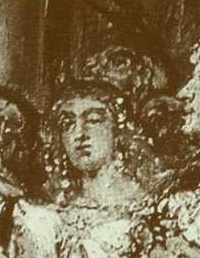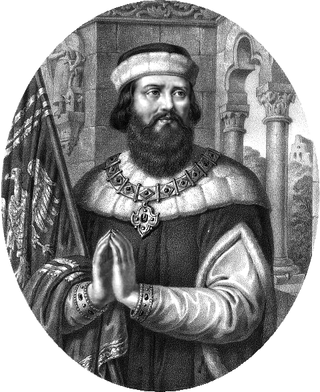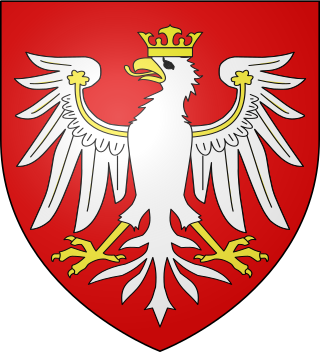Related Research Articles
Judith of Poland was a member of the House of Piast and by marriage margravine of Brandenburg.

Bolesław III Wrymouth, also known as Boleslaus the Wry-mouthed, was the duke of Lesser Poland, Silesia and Sandomierz between 1102 and 1107 and over the whole of Poland between 1107 and 1138. He was the only child of Duke Władysław I Herman and his first wife, Judith of Bohemia.

Lestek was the second duke of Polans, and son of Siemowit, born c. 870–880, mentioned in the oldest Polish chronicle, Gesta principum Polonorum by Gallus Anonimus. The dukes of Polans were the foundation of the Piast dynasty, the first historical ruling dynasty of Poland.
Zbigniew, was a duke of Poland during 1102–1107. He was the first-born son of Władysław I Herman and Przecława, possibly a member of the Prawdzic family.

Bezprym was the duke of Poland from 1031 until his death. He was the eldest son of the Polish king Bolesław the Brave, but was deprived of the succession by his father, who around 1001 sent him to Italy in order to become a monk at one of Saint Romuald's hermitages in Ravenna.

Leszek of Masovia was a Polish prince from the Piast dynasty, the Duke of Masovia from 1173 until his death. He was the only son of Bolesław IV the Curly, Duke of Masovia and High Prince of Poland, to survive his father. After his father's death he inherited Masovia. At the beginning, Leszek ruled under the guardianship of his uncle Casimir II the Just. He was a man of poor health. For a short time he supported his other uncle, Mieszko III the Old, but later decided to reconcile with Casimir II, who after Leszek's death inherited his duchy.
Henry I of Sandomierz was the duke of Sandomierz from 1138 until his death. He took part in the Second Crusade. Upon his return from the Holy Land, Henry organized a battle against the Prussians and died in battle.

Theodoric I, a member of the House of Wettin, was Margrave of Lusatia from 1156 until his death.

Helena of Znojmo, was a Bohemian princess, a member of the Přemyslid dynasty. She was the daughter of Duke Conrad II of Znojmo and his Serbian wife Marija of Rascia. Helena was probably named after her maternal aunt, Queen Helena of Hungary, wife of King Béla II.

Konrad Laskonogi, was a Duke of Głogów since 1177 until his death.
Elizabeth of Hungary was a member of the House of Árpád and by marriage Duchess of Greater Poland.
Mieszko Kazimierzowic was a Polish prince member of the House of Piast. According to some scholars, he was probably Duke of Kuyavia since 1058 until his death.

Casimir II the Just was a Lesser Polish Duke of Wiślica from 1166 to 1173, and of Sandomierz after 1173. He became ruler over the Polish Seniorate Province at Kraków and thereby High Duke of Poland in 1177; a position he held until his death, though interrupted once by his elder brother and predecessor Mieszko III. In 1186 Casimir also inherited the Duchy of Masovia from his nephew Leszek, becoming the progenitor of the Masovian branch of the royal Piast dynasty, and great-grandfather of the later Polish king Władysław I the Elbow-high. The honorific title "the Just" was not contemporary and first appeared in the 16th century.
Mieszko Mieszkowic, was a Polish prince, and a member of the House of Piast.
Lambert Mieszkowic, was a Polish prince of the House of Piast.

Regelinda, also known as the "Smiling Polish woman", was a Polish princess from the Piast dynasty and Margravine of Meissen from 1009 until her death by her marriage to Herman I.
Otto Bolesławowic (1000–1033) was member of the House of Piast. He was the third son of King Bolesław the Brave of Poland. Having inherited no land from his father, he fled to Germany. After the defeat of his brother Mieszko II Lambert in 1032, Otto received a part of Poland to rule but died shortly after.
Agnes of Poland was a member of the House of Piast and by marriage princess of Pereyaslavl and Volynia and grand princess of Kiev since 1168.

Elisabeth of Greater Poland was a Polish princess of the House of Piast and, by her two marriages, Duchess of Bohemia and Margravine of Lusatia.
The German–Polish War was a conflict fought between 1028 and 1031. It was fought by the Holy Roman Empire led by Conrad II, the Duchy of Bohemia led by Bretislav I, the Kievan Rus' led by Yaroslav the Wise and, from 1031, the Kingdom of Hungary led by Stephen I, against the Kingdom of Poland led by Mieszko II Lambert and, until 1031, the Kingdom of Hungary led by Stephen I. The war had begun with Polish attacks on Saxony within the Holy Roman Empire. Following that, the Empire and the Kievan Rus' had attacked Poland, winning the war in 1031. Following the German victory, Mieszko II Lambert was forced to abdicate, losing the title of the King of Poland, and his country being reformed into the Duchy of Poland, with Bezprym as a duke.
References
- Jasiński, Kazimierz (1992). Rodowód pierwszych Piastów. Warszawa - Wrocław: Uniwersytet Wrocławski - Oficyna Wydawnicza VOLUMEN. p. 251. ISBN 83-85218-32-7.
- Maleczyński, Karol (1939–1946). "Dobronega Ludgarda". Polski Słownik Biograficzny. Vol. 5. Polska Akademia Nauk & Polska Akademia Umiejętności. p. 248.